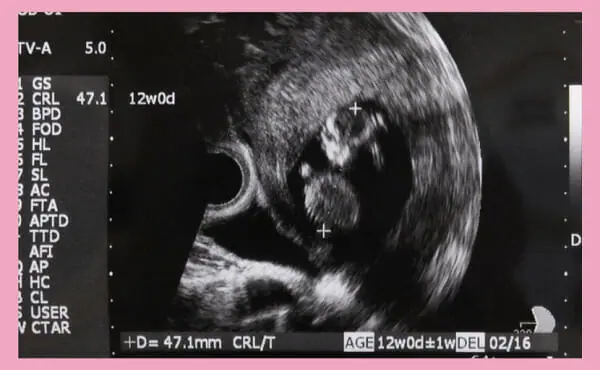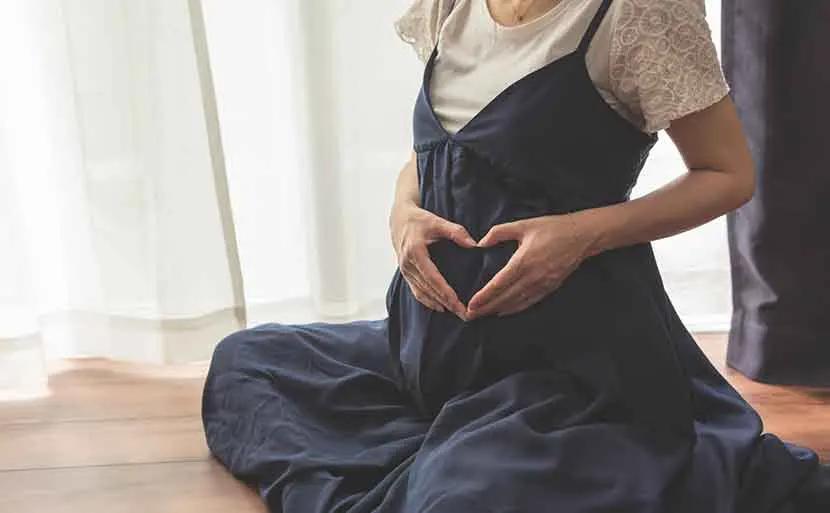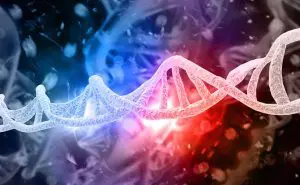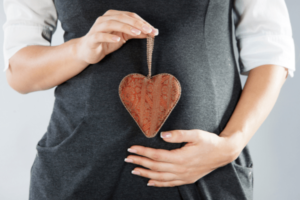Follow the poignant journey of a mother and baby at 12 weeks as Down syndrome is revealed by an echocardiogram, with sensitive insights supervised by our medical experts at Hiro Clinic.
Babies at 12 weeks’ gestation
How big and heavy has your baby grown at around 12 weeks’ gestation?
Here is a closer look at the condition of the baby at 12 weeks’ gestation and whether the sex can be determined.
Baby condition
The average size of a baby at around 12 weeks’ gestation is approximately 5-6 cm in crown-rump length (CRL), a measure of the baby’s size.
The CRL is a measurement of the length of the foetus from the tip of the head to the hips.
If compared to a fruit, it is about the size of a mandarin orange.
It weighs about 40-50 g, which is about the weight of an egg.
In terms of physical development, this is the time when the formation of the various organs is completed and the facial features and muscles gradually develop.
In addition, the amount of amniotic fluid protecting the baby’s body increases and the limbs become more active.
This is also the time when the differences between the external genitalia of the sexes can be seen and the human-like physical appearance of the body can be confirmed.

Gender determination of the baby
The sex of the baby at around 12 weeks’ gestation may be determined by ultrasound examination.
Babies at this time will show differences in their external genitalia, so if the external genitalia can be seen on ultrasound, the sex of the baby will be known.
However, it is not possible to know for sure, as the baby may not have grown enough to make a clear determination.
NIPT is a method to determine the sex of the baby with a high probability even at around 12 weeks’ gestation.
NIPT is a genetic test that is performed without surgically damaging the mother’s body.
The mother’s blood and amniotic fluid are taken to check the foetus’ DNA to determine genetic abnormalities and gender.
However, facilities accredited by the Japanese Society of Obstetrics and Gynaecology for NIPT do not carry out tests for the purpose of gender confirmation.
Mothers at 12 weeks’ gestation
What changes are occurring in the mother’s body at around 12 weeks’ gestation?
Here we take a closer look at the mother’s condition at 12 weeks’ gestation and what to look out for.
Maternal condition
At around 12 weeks’ gestation, the belly begins to swell slightly as the baby gets bigger.
The placenta, which exchanges nutrients and oxygen with the baby and produces blood, is also completed around 12 weeks’ gestation.
Morning sickness, which is accompanied by loss of appetite and nausea, gradually subsides around the 12th week of pregnancy.
As morning sickness subsides, appetite gradually increases and many women tend to overeat.
To avoid sudden weight gain, be careful with your diet, making sure you have a well-balanced diet.
What mothers need to be aware of at 12 weeks’ gestation
At 12 weeks’ gestation, a mother’s body undergoes many changes.
With changes come things to be aware of, so here we look at what mothers need to be aware of at 12 weeks’ gestation.
Choose clothing that does not put pressure on the abdomen
At 12 weeks’ gestation, the belly may feel a little puffy or tense.
Although it is not yet noticeably large, you should avoid wearing tight clothes that put pressure on your belly.
If you put pressure on your abdomen, this can cause poor blood circulation and over-contraction of the uterus, which can put strain on the baby.
Choose loose-fitting or maternity clothes that are loose around the abdomen, depending on how swollen your belly is.
The urge to urinate becomes closer
As the baby gets bigger, the bladder may be under pressure, making it easier for the baby to urinate.
If the urge to urinate is closer, the number of trips to the toilet will increase.
However, it is not advisable to hold back urination because you do not want to have to go to the toilet more than once.
This is because the urethra of a pregnant woman’s urethra is less tight due to hormones, which can easily stop bacteria, and holding it back can lead to bacterial growth.
Bacterial growth puts you at risk of cystitis, so do not hold back if you feel the urge to urinate.
May have abdominal pain
Many mothers experience abdominal pain by the 15th week.
Abdominal pain during this period can be caused by the baby’s growth, changes in the size of the uterus, hormonal effects of constipation and diarrhoea due to poor bowel function.
If the pain gradually subsides, there may be no major problems, but there is a possibility of an early miscarriage before the 12th week of pregnancy.
If the pain gradually increases or bleeding occurs, consider consulting a doctor.

Down syndrome and 12-week features revealed by echography
This section will now touch on what an ultrasound scan (ultrasound examination) can reveal.
Echocardiography allows you to see how the baby is developing and can confirm suspicions of 21 trisomy (Down syndrome), a known chromosomal abnormality, by looking at the back of the foetus’ neck, the length of the limbs and other parts of the body.
When can the suspicion of 21 trisomy (Down syndrome) be confirmed, generally at 10-15 weeks.
It is not always a 21 trisomy (Down syndrome) if the length of the limbs or the size of the face are not average, but a state of suspicion.
Some mothers do not know that they had a 21 trisomy (Down syndrome) during pregnancy, so care should be taken not to rule it out at 12 weeks.
Swelling at the back of the neck
In the early stages of 21 trisomy (Down syndrome), there is swelling in the back of the head and neck.
The swelling appears dark and shadowy in the images of the test results, but if it appears thicker than the back of the neck of a baby without a 21 trisomy (Down syndrome), a 21 trisomy (Down syndrome) is suspected.
In technical terms, the swelling at the back of the neck is expressed as NT (short for Nuchal Translucency), which is found at 11-13 weeks’ gestation and is present in all babies.
The standard value for NT is less than 3.5 mm, but it is also determined by the CRL (crown-rump length), which is the length of the foetal head from the head to the buttocks.
It should be noted that an NT of more or less than 3.5 mm is not definitive.
Shortness of limbs
In cases of chromosomal abnormalities such as 21 trisomy (Down syndrome), the limbs tend to be shorter.
The FL value (abbreviation of Femur Length) for thigh length is also used as one of the determining factors.
Head size
It is determined from the BPD (Biparietal Diameter) and FOD (Front Occipital Diameter) values.
BPD indicates the horizontal width of the skull, while FOD indicates the vertical width.
For BPD, the average size is 15-35 mm at 12-15 weeks, but if the value is more than 10% of the average, a 21 trisomy (Down syndrome) is suspected.
Nasal bones and facial features
In the case of 21 trisomy (Down syndrome), the entire face has a flattened appearance and the nasal bones may appear small or the lips may appear small on echocardiography.
The nose is observed when the CRL has grown to 45~84 mm.
Heart
About half of babies with 21 trisomy (Down syndrome) have a heart condition. Congenital heart disease or 21 trisomy (Down syndrome) is suspected when there is regurgitation of blood in the tricuspid valve between the right ventricle and right atrium of the heart.
However, regurgitation can also be seen in babies without a 21 trisomy (Down syndrome), so it does not necessarily confirm the presence of the condition.
Also, as it is not easy to diagnose heart disease in early pregnancy up to 15 weeks, the decision is made after a specialist doctor has examined the baby and a more detailed ‘foetal echocardiogram’ has been performed.
12-week pregnancy test
What are the tests that you can undergo at around 12 weeks’ gestation?
Here are some of the tests you can take at 12 weeks’ gestation and the tests you may want to do.
Prenatal care
Pregnancy check-ups are examinations carried out regularly during pregnancy to check the health of the mother and baby.
According to the guidelines of the Ministry of Health, Labour and Welfare, the frequency of antenatal check-ups at 12 weeks’ gestation should be approximately once every four weeks.
The following tests are mainly carried out during antenatal check-ups
- Basic information (e.g. height, weight, BMI, blood pressure)
- Blood test
- Cervical cytology test
Find out more about each of these inspections.
Basic information (e.g. height, weight, BMI, blood pressure)
First, the antenatal care team collects basic information needed for the management of the pregnancy.
From tests such as height, weight, BMI, blood pressure, urine protein and urine sugar, a questionnaire is used to elicit detailed information about the pregnant woman herself.
Blood test
The blood test will check the following laboratory tests
- ABO blood group, Rh blood group
Ensure that the mother is able to cope with a blood group incompatible pregnancy, which may require a blood transfusion or in which the mother develops antibodies against the baby’s red blood cells.
- Irregular antibody screening
A test for irregular antibodies in the blood.
Irregular antibodies may react with the baby’s blood and destroy blood cells.
- Blood count
This test examines the composition of the blood, including white blood cell count, red blood cell count, haemoglobin and platelets.
The test values indicate inflammatory conditions, anaemia, immunity and haemostatic activity.
- Blood sugar
Blood glucose is a test for sugar in the blood.
During pregnancy, enzymes from the placenta make it difficult to control blood sugar levels, which can lead to gestational diabetes.
- HBs antigen, HCV antibodies, rubella antibodies, syphilis screening, HTLV-1 antibodies, HIV screening, toxoplasma antibodies
The above tests confirm whether the mother has antigens or antibodies.
Proper conditions can prevent the risk of mother-to-child transmission.
Cervical cytology test
A cervical cytology test involves taking cells from the cervix and checking for abnormalities under a microscope.
The test can lead to the detection of cervical and vaginal cancer.
The cervical cytology test in early pregnancy is for women who have not had a test for a certain period of time.

Self-funded tests
In addition to antenatal check-ups, which are recommended on a regular basis, other tests available at your own expense during pregnancy for genetic abnormalities and congenital diseases include maternal serum markers (also known as quattro tests), combined tests and NIPT.
Maternal serum markers can be performed around 15~17 weeks, combined testing around 11~13 weeks and NIPT between 10~22 weeks.
The cost of NIPT in Japan varies widely from facility to facility, ranging from about 90,000-240,000 yen (excluding tax) for tests for 21, 18 and 13 trisomy only.
At Hiro Clinic NIPT, prices are set according to the type of gene to be examined.
There is also the N-Scan ADD plan, which costs ¥230,780 including tax, for those who want to know the various possibilities, including a plan that costs ¥53,680 including tax to test a single gene and a plan that costs ¥98,780 including tax to test the 21st, 18th and 13th genes.
One thing to note about NIPT is that the test results do not give a concise answer such as ‘yes / no’.
The reason is that NIPT is a screening test, which indicates whether a pregnancy is at ‘high’ or ‘low’ risk of a disease, rather than the result of whether the pregnancy has a chromosomal disease or not.
The NIPT test also involves some pain due to blood sampling, but this is not considered to have a significant effect on the foetus in principle.
It should be noted that after the NIPT test, there is a possibility of performing confirmatory tests such as trophoblastic and amniotic fluid tests, and it cannot be said that there is no possibility of miscarriage or water breakage when it comes to performing a confirmatory test.
However, confirmatory tests after NIPT, such as chorionic villus and amniotic fluid tests, are not mandatory when the test is positive, but are performed only after the mother has requested them.
Please feel free to contact us for a friendly explanation of each NIPT plan and what you need to be aware of.
Things to do at 12 weeks’ gestation
When you are 12 weeks pregnant, you should do the following
- Weight control
- Preparing maternity wear
- Care of stretch marks
- Consideration of NIPT
At 12 weeks’ gestation, morning sickness gradually subsides.
It should be noted that as morning sickness subsides, appetite increases and weight gain is more likely.
Therefore, manage your weight to prevent rapid weight gain.
Some people have morning sickness that does not end, but it may be characterised by the baby growing and putting pressure on the internal organs, hormonal imbalance, stress or cold.
As the causes are different for everyone, it is important to learn to deal with morning sickness in your own way, as there is no coping mechanism or control method that will always relieve it.
Also, around the 12th week of pregnancy, unlike the first three weeks of pregnancy, your belly is getting bigger and bigger.
As your belly swells, the clothes you have been wearing may put pressure on your abdomen.
You should start preparing maternity wear from about 12 weeks’ gestation, when your abdomen starts to show.
As your belly grows, you may also develop lines on your abdomen, known as stretch marks.
To prevent stretch marks, it is important to moisturise and massage with creams and oils.
Take good care and prevent stretch marks.
Finally, if you want to know the health of your unborn baby, NIPT is recommended.
Knowing your baby’s condition before birth will help you prepare to be flexible.
Summary
In this article, we have described the condition of the baby and mother at 12 weeks’ gestation and what can be done.
At around 12 weeks, the baby is growing and becoming more and more human, while the mother’s body is becoming more pregnant as the baby grows.
Regular antenatal check-ups will help to ensure the health of the baby and mother as they move towards delivery.
However, there are some things that cannot be determined by antenatal check-ups alone, so if you want to know more about your health, a NIPT at around 12 weeks’ gestation is one way to find out more.
NIPT at Hiro Clinic NIIPT is usually delivered within 2-5 days※1,2 from blood collectionand early test results are available. In addition, an express delivery option is available at all Hiro Clinic NIIPT clinics except the collaborating facilities (delivery within 2~3 days of blood collection).
※1 Usually within 3-6 days for some clinics and linked facilities
※2Excluding some plans
If you are considering an inspection, please consider.
【References】
- The Japanese Society of Obstetrics and Gynaecology, Japan – Guidelines for the Practice of Obstetrics and Gynaecology – Obstetrics Edition 2020
- The Japanese Society of Obstetrics and Gynaecology – History and current status of the revision of the “Prenatal genetic testing using maternal blood (NIPT)” guidelines
Follow the poignant journey of a mother and baby at 12 weeks as Down syndrome is revealed by an echocardiogram, with sensitive insights supervised by our medical experts at Hiro Clinic.
Article Editorial Supervisor

岡 博史先生
【役職】
【資格】
【略歴】
【所属】
【SNS】
 中文
中文













